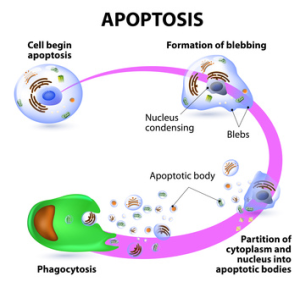Caspases (cysteine-dependent aspartate-directed proteases) belong to the family of cysteine proteases and are involved in networks controlling cell death (apoptosis and necrosis) and inflammation. 12 human caspases have been described so far (1.). Human Caspases have been classified according to their roles in apoptosis (Caspase-3, -6, -7, -8, and -9) and inflammation (Caspase-1, -4, -5, and -12). Caspase-2, -10, and -14 can be less easily classified concerning the function (for an overview see 2.).
So let’s take a further look at their role, and some of the tools available to investigate and screen compounds modifying Caspase activities.
 Caspases in Apotosis
Caspases in Apotosis
Caspases involved in apoptosis can be further divided into Initiator Caspases (Caspase-8, and -9) and Executioner Caspases (Caspase-3, -6, and -7). Initiator Caspases are activated by dimerization of inactive procaspase monomers, while Executioner Caspases have to be cleaved and thus activated by Initiator Caspases. Executioner Caspase exist as procaspase dimers which upon cleavage and subsequent conformational change results in the mature and active enzyme. The activated Executioner Caspases finally lead to destruction of key structural proteins and activate other enzymes.
Caspases in Inflammation
The above mentioned Caspases (Caspase-1, -4, -5, and -12; in mice Caspase-1, -11, and -12 serve the same function) play a critical role as mediators of innate immune responses. These caspases are generated as inactive procaspases as well and are activated after cellular stimulation and the formation of the inflammasome complex. Finally activated Caspase-1 cleaves the proinflammatory cytokines IL-1β, pro-IL-18, and pro-IL-33, thus facilitating their secretion which leads to inflammation (3.).
Caspases involved in human diseases
Defective Caspase activities can be involved in the pathology of a number of human diseases.
- Cancer: Non-conforming Caspase activation and consequential inadequte cell death can lead to tumorigenesis.
- Neurodegenerative diseases: Hyper activation of Caspases and resulting excessive cell death is able to promote neurodegenerative conditions.
- Infection/Inflammation: Increased sensitivity to infection can be caused by insufficient Caspase activation, while over-activation of the same Caspases can lead to inflammatory conditions.
Tools to investigate and screen compounds modifying Caspase activities
Looking at the roles of Caspases in diverse human diseases, it becomes obvious that both Caspase inhibitors as well as Caspase activitors can be considered as potential drug candidates. Here, I’ll summarize some of the tools which are available to measure Caspase activity and/or inhibitors effects of compounds on Caspase activity.

BPS Biosciences recently launched homogenous assays to measure the activity of:
All these kits kits allow you to measure enzyme activity and effects of Caspase modulators. They come in a convenient 96-well format, with all the reagents necessary for 100 fluorescent Caspase activity measurements. In addition, the kits include purified Caspases enzyme and a potent Caspase inhibitor for use as a positive and negative control. The fluorogenic substrate in the kit is incubated with purified Caspase and the enzymatic activity releases AFC fluorophore that can then be measured using a fluorescence reader.

Furthermore, Anaspec offers kits as well to measure activity and inhibition of:
Again, these homogenous kits are meant to screen for specific Caspase inhibitors and to measure the activity of the enzymes. The read-out can be done with a fluorescence plater reader as well.
Last (but not least of course!), you can also explore a range of:
- active Caspases
- Caspase modulators
- Anti-Caspase antibodies
- Caspase subtrates
- Cell Based Caspase detection and activity assays
I’ll especially come back to cell based activity assays (to detect active Caspases in cells) and the Caspase modulators in a future blog.
If you’re interested in more information or would like to leave a comment, feel free below!
References:
1. HUGO Gene Nomenclature Committee: http://www.genenames.org/cgi-bin/genefamilies/set/468
2. David R. McIlwain, Thorsten Berger, and Tak W. Mak, Caspase Functions in Cell Death and Disease, Cold Spring Harb Perspect Biol 2013; 5:a008656.
3. F. Martinon, K. Burns, and J. Tschopp, The inflammasome: A molecular platform triggering activation of inflammatory caspases and processing of proIL-β, Mol Cell 10: 417–426 (2002)


